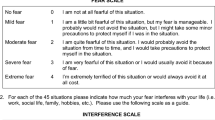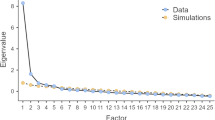Abstract
Assessment options are extremely limited for the evaluation of treatment outcome in a specific phobia of vomiting (emetophobia). We aimed to assist researchers and clinicians in the measurement of cognitive processes and behaviors that are characteristic of the disorder for treatment planning and outcome measurement. We developed the specific phobia of vomiting inventory (SPOVI). A series of measures, including the SPOVI, were given to two groups: a group diagnosed with a specific phobia of vomiting and a community control group. Item characteristics, reliability, and factor structure were analysed. Convergent validity with measures of related constructs was determined. The SPOVI was found to have good reliability and validity in the measurement of a phobia of vomiting. The scale has a two-factor structure, with one factor characterised by avoidance symptoms and a second factor comprised of threat monitoring. It is sensitive to change during treatment. The results provide initial evidence of the psychometric qualities of the SPOVI and its suitability for use in clinical practice and research.


Similar content being viewed by others
References
American Psychiatric Association. (1994). Diagnostic and statistical manual of mental disorders (4th ed.). Washington, DC: Author.
Antony, M. M. (2001). Measures for specific phobia. In M. M. Antony, S. M. Orsillo, & L. Roener (Eds.), Practitioner’s guide to empirically based measures of anxiety (pp. 133–158). New York: Kluwer.
Becker, E. S., Rinck, M., Türke, V., Kause, P., Goodwin, R., Neumer, S., et al. (2007). Epidemiology of specific phobia subtypes: Findings from the Dresden Mental Health Study. European Psychiatry, 22, 69–74.
Boschen, M. J. (2007). Reconceptualizing emetophobia: A cognitive-behavioral formulation and research agenda. Journal of Anxiety Disorders, 21, 407–419.
Boschen, M. J., Veale, D., Ellison, N., & Reddell, T. (in submission). The emetophobia questionnaire (EmetQ-13): Psychometric validation of a measure of specific phobia of vomiting. Manuscript submitted for publication.
Boschen, M. J., & Oei, T. P. S. (2006). Factor structure of the mood and anxiety symptom questionnaire does not generalize to an anxious/depressed sample. Australian and New Zealand Journal of Psychiatry, 40, 1017–1026.
Clark, D. M., Layard, R., Smithies, R., Richards, D. A., Suckling, R., & Wright, B. (2009). Improving access to psychological therapy: Initial evaluation of two UK demonstration sites. Behaviour Research and Therapy, 47, 910–920.
Foa, E. B., Kozak, M. J., Salkovskis, P. M., Coles, M. E., & Amir, N. (1998). The validation of a new obsessive-compulsive disorder scale: The obsessive compulsive inventory. Psychological Assessment, 10, 206–214.
Haidt, J., McCauley, C., & Rozin, P. (1994). Individual differences in sensitivity to disgust: A scale sampling seven domains of disgust elicitors. Personality and Individual Differences, 16, 701–713.
Harvey, A., Watkins, E., Mansell, W., & Shafran, R. (2004). Cognitive behavioural processes across psychological disorders: A trans-diagnostic approach to research and treatment. Oxford: University Press.
Horn, J. (1965). A rationale and test for the number of factors in factor analysis. Psychometrika, 30, 179–185.
Hunter, P. V., & Antony, M. M. (2009). Cognitive-behavioral treatment of emetophobia: The role of interoceptive exposure. Cognitive and Behavioral Practice, 16, 84–91.
Jacobsen, N. S., Roberts, L. J., Berns, S. B., & McGlinchey, J. B. (1999). Methods of defining and determining the clinical significance of treatment effects: Description, application, & alternatives. Journal of Consulting and Clinical Psychology, 67, 300–307.
Kirkpatrick, D. R., & Berg, A. J. (1981). Fears of a heterogeneous non-psychiatric sample. Paper presented at the Annual Conference of the American Psychological Association. Los Angeles, CA.
Kroenke, K., & Spitzer, R. L. (2002). The PHQ-9: A new depression diagnostic and severity measure. Psychiatric Annals, 32, 509–515.
Lesage, A., & Lamontagne, Y. (2003). Paradoxical intention and exposure in vivo in the treatment of psychogenic nausea: Report of two cases. Behavioural Psychotherapy, 13, 69–75.
Lipsitz, J. D., Fyer, A. J., Paterniti, A., & Klein, D. F. (2001). Emetophobia: Preliminary results of an internet survey. Depression and Anxiety, 14, 149–152.
Lorenzo-Seva, U., & Ferrando, P. J. (2006). FACTOR: A computer programme to fit the exploratory factor analysis model. Behavioral Research Methods, Instruments and Computers, 38, 88–91.
Manassis, K., & Kalman, E. (1990). Anorexia resulting from fear of vomiting in four adolescent girls. Canadian Journal of Psychiatry, 35, 548–550.
McFadyen, M., & Wyness, J. (1983). You don’t have to be sick to be a behaviour therapist but it can help! Treatment of a “Vomit” Phobia. Behavioural Psychotherapy, 11, 173–176.
McKenzie, S. (1994). Hypnotherapy for vomiting phobia in a 40 year old woman. Contemporary Hypnosis, 11, 37–40.
Moran, D. J., & O’Brien, R. M. (2005). Competence imagery: A case study treating emetophobia. Psychological Reports, 96, 635–636.
Mundt, J. C., Marks, I. M., Shear, M. K., & Greist, J. H. (2002). The work and social adjustment scale: A simple measure of impairment in functioning. British Journal of Psychiatry, 180, 461–464.
O’Connor, J. J. (1983). Why can’t I get hives: Brief strategic therapy with an obsessional child. Family Process, 22, 201–209.
Olatunji, B. O., Williams, N. L., Tolin, D. F., Abramowitz, J. S., Sawchuk, C. N., Lohr, J. M., et al. (2007). The disgust scale: Item analysis, factor structure, and suggestions for refinement. Psychological Assessment, 19, 281–297.
Philips, H. C. (1985). Return of fear in the treatment of a fear of vomiting. Behaviour Research and Therapy, 23, 45–52.
Price, K., Veale, D., & Brewin, C. R. (2012). Intrusive imagery in people with a specific phobia of vomiting. Journal of Behavior Therapy and Experimental Psychiatry, 43, 672–678.
Reddell, T. (2006). Developing the Emetophobia Questionnaire (Unpublished honours thesis). Australia: Griffith University.
Ritow, J. K. (1979). Brief treatment of a vomiting phobia. American Journal of Clinical Hypnosis, 21, 293–296.
Salkovskis, P. M., Rimes, K. A., Warwick, H. M. C., & Clark, D. M. (2002). The health anxiety inventory: Development and validation of scales for the measurement of health anxiety and hypochondriasis. Psychological Medicine, 32, 843–853.
Spitzer, R. L., Kroenke, K., Williams, J. B. W., & Löwe, B. (2006). A brief measure for assessing generalized anxiety disorder: The GAD-7. Archives of Internal Medicine, 166, 1092–1097.
van Overveld, M., de Jong, P. J., Peters, M. L., van Hout, W. J. P. J., & Bouman, T. K. (2008). An internet-based study on the relation between disgust sensitivity and emetophobia. Journal of Anxiety Disorders, 22, 524–531.
Veale, D. (2009). Cognitive behaviour therapy for a specific phobia of vomiting. The Cognitive Behaviour Therapist, 2, 272–288.
Veale, D., Costa, A., Murphy, P., & Ellison, N. (2012a). Abnormal eating behaviour in people with a specific phobia of vomiting (emetophobia). European Eating Disorders Review, 20, 414–418.
Veale, D., & Lambrou, C. (2006). The psychopathology of vomit phobia. Behavioural and Cognitive Psychotherapy, 34, 139–150.
Veale, D., Murphy, P., Ellison, N., Kanakam, N., & Costa, A. (2012b). Auto-biographical memories in people with a specific phobia of vomiting. Journal of Behaviour Therapy and Experimental Psychiatry, 44, 14–20.
Wijesinghe, B. (1974). A vomiting phobia overcome by one session of flooding with hypnosis. Journal of Behavior Therapy and Experimental Psychiatry, 5, 169–170.
Wilson, P., & Cooper, C. (2008). Finding the magic number. The Psychologist, 21, 866–867.
Wolitzky-Taylor, K. B., Horowitz, J. D., Powers, M. B., & Telch, M. J. (2008). Psychological approaches in the treatment of specific phobias: A meta-analysis. Clinical Psychology Review, 28, 1021–1037.
Zimmerman, M., & Mattia, J. I. (2001). A self-report scale to help make psychiatric diagnoses: The psychiatric diagnostic screening questionnaire. Archives of General Psychiatry, 58, 781–794.
Zwick, W. R., & Velicer, W. F. (1986). Comparison of five rules for determining the number of components to retain. Psychological Bulletin, 99, 432–442.
Conflict of interest
None.
Author information
Authors and Affiliations
Corresponding author
Rights and permissions
About this article
Cite this article
Veale, D., Ellison, N., Boschen, M.J. et al. Development of an Inventory to Measure Specific Phobia of Vomiting (Emetophobia). Cogn Ther Res 37, 595–604 (2013). https://doi.org/10.1007/s10608-012-9495-y
Published:
Issue Date:
DOI: https://doi.org/10.1007/s10608-012-9495-y




